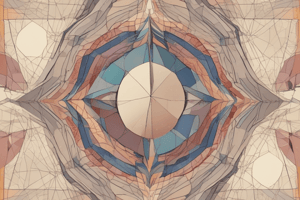Podcast
Questions and Answers
What is the primary purpose of dividing the surface into a series of parallel lines in parallel line development?
What is the primary purpose of dividing the surface into a series of parallel lines in parallel line development?
- To find the surface area of the shape
- To create a two-dimensional representation
- To determine the shape of a pattern (correct)
- To calculate the volume of the shape
What type of shapes are suitable for radial line development?
What type of shapes are suitable for radial line development?
- Cube and rectangular prism
- Sphere and hemisphere
- Prism and cylinder
- Cone and pyramid (correct)
What is the characteristic of elements in a developed cylinder?
What is the characteristic of elements in a developed cylinder?
- They are parallel and perpendicular to the base (correct)
- They are diagonal and parallel to the top
- They are curved and parallel to the development plane
- They are radial and perpendicular to the base
What is the condition for a shape to be suitable for parallel-line development?
What is the condition for a shape to be suitable for parallel-line development?
What is the shape of the base and top of a developed cylinder?
What is the shape of the base and top of a developed cylinder?
What is the orientation of the cylinder during development?
What is the orientation of the cylinder during development?
Flashcards
Purpose of parallel lines in pattern development?
Purpose of parallel lines in pattern development?
Determines the shape and size needed for a flat pattern that can be formed into the desired 3D object.
Shapes for Radial Line Development?
Shapes for Radial Line Development?
Shapes that converge at a single point, like cones or pyramids, are suitable for radial line development.
Developed Cylinder Element Characteristics?
Developed Cylinder Element Characteristics?
Elements are parallel to each other and perpendicular to the circular bases.
Parallel-Line Development Condition
Parallel-Line Development Condition
Signup and view all the flashcards
Developed Cylinder Base and Top Shape?
Developed Cylinder Base and Top Shape?
Signup and view all the flashcards
Cylinder Orientation During Development?
Cylinder Orientation During Development?
Signup and view all the flashcards
Study Notes
Parallel Line Development
- Uses parallel lines to construct the expanded pattern of 3D shapes.
- Divides the surface into a series of parallel lines to determine the shape of a pattern.
- Examples: Prism, Cylinder.
Radial Line Development
- Uses lines radiating from a central point to construct the expanded pattern of 3D shapes.
- Examples: Cone, Pyramid.
Characteristics of Parallel-Line Developments
- Made from common solids composed of parallel lateral edges or elements.
- Examples: Prisms and cylinders.
- The cylinder is positioned with one element lying on the development plane.
- The cylinder is unrolled until it is flat on the development plane.
- The base and top of the cylinder are circles, with a circumference equal to the length of the development.
- All elements of the cylinder are parallel and perpendicular to the base and the top.
- When cylinders are developed, all elements are parallel and any perpendicular section appears as a stretch-out line perpendicular to the elements.
Studying That Suits You
Use AI to generate personalized quizzes and flashcards to suit your learning preferences.




